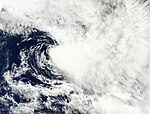2011–12 South Pacific cyclone season
| 2011–12 South Pacific cyclone season |

Season summary map
|
| Seasonal boundaries |
| First system formed |
November 13, 2011 |
| Last system dissipated |
April 11, 2012 |
| Strongest storm |
|
| Name |
Jasmine |
| • Maximum winds |
195 km/h (120 mph)
(10-minute sustained) |
| • Lowest pressure |
937 hPa (mbar) |
| Seasonal statistics |
| Total disturbances |
20 |
| Total depressions |
16 |
| Tropical cyclones |
3 |
| Severe tropical cyclones |
1 |
| Total fatalities |
18 |
| Total damage |
> $17.2 million (2012 USD) |
| Related articles |
|
|
South Pacific tropical cyclone seasons
2009–10, 2010–11, 2011–12, 2012–13, 2013–14
|
| Tropical disturbance (Australian scale) |
|
|
| Duration |
November 13 – November 16 |
| Peak intensity |
Winds not specified 1004 hPa (mbar) |
| Tropical depression (Australian scale) |
|
|
| Duration |
December 28 – January 1 |
| Peak intensity |
Winds not specified 1002 hPa (mbar) |
| Tropical disturbance (Australian scale) |
|
|
| Duration |
January 7 – January 8 |
| Peak intensity |
Winds not specified 1001 hPa (mbar) |
| Tropical depression (Australian scale) |
|
|
| Duration |
January 8 – January 9 |
| Peak intensity |
Winds not specified 1000 hPa (mbar) |
| Tropical disturbance (Australian scale) |
|
|
| Duration |
January 8 – January 10 |
| Peak intensity |
Winds not specified 1000 hPa (mbar) |
| Tropical depression (Australian scale) |
|
|
| Duration |
January 19 – January 25 |
| Peak intensity |
Winds not specified 1001 hPa (mbar) |
| Tropical depression (Australian scale) |
|
|
| Duration |
January 26 – February 2 |
| Peak intensity |
55 km/h (35 mph) (10-min) 994 hPa (mbar) |
| Tropical depression (Australian scale) |
|
|
| Duration |
January 25 – January 28 |
| Peak intensity |
Winds not specified 1001 hPa (mbar) |
| Tropical depression (Australian scale) |
|
|
| Duration |
January 30 – January 31 |
| Peak intensity |
55 km/h (35 mph) (10-min) 998 hPa (mbar) |
The 2011–12 South Pacific cyclone season was one of the least active South Pacific tropical cyclone seasons on record, with only three tropical cyclones occurring during the season. The season ran from November 1, 2011 to April 30, 2012, however, any tropical cyclones that form before June 30, 2012 would have fallen within the 2011–12 tropical cyclone year and would have counted towards the season total. The strongest and only severe tropical cyclone that occurred during the season was Severe Tropical Cyclone Jasmine, which tracked in from out of the South Pacific basin. Within the basin, tropical cyclones are monitored by the Regional Specialized Meteorological Center (RSMC) in Nadi, Fiji, and the Tropical Cyclone Warning Center (TCWC) in Wellington, New Zealand. RSMC Nadi attaches an F designation to tropical disturbances that form in or move into the South Pacific. The United States Joint Typhoon Warning Center (JTWC) issues unofficial warnings within the South Pacific, designating tropical storm-equivalent or greater tropical cyclones with a number and a P suffix. RSMC Nadi and TCWC Wellington both use the Australian Tropical Cyclone Intensity Scale, and measure windspeeds over a period of ten minutes, while the JTWC measures sustained winds over a period of one minute and uses the Saffir–Simpson Hurricane Scale.
Ahead of the cyclone season, RSMC Nadi, TCWC Wellington, the Australian Bureau of Meteorology (BoM), the New Zealand National Institute of Water and Atmospheric Research (NIWA) and various other Pacific Meteorological services, all contributed towards the Island Climate Update tropical cyclone outlook that was released in October 2011. The outlook took into account analogue seasons and the La Nina conditions that were developing across the Pacific. The outlook called for a below average number of tropical cyclones for the 2011–12 season, with five to eight named tropical cyclones, to occur between 135°E and 120°W compared to an average of around nine. At least one these cyclones was expected to become either a category 3 or a category 4 severe tropical cyclone, while there was a reduced chance of a Category 5 severe tropical cyclone. In addition to contributing towards the Island Climate Update outlook, RSMC Nadi and the BoM issued their own seasonal forecasts for the South Pacific region.
...
Wikipedia

















